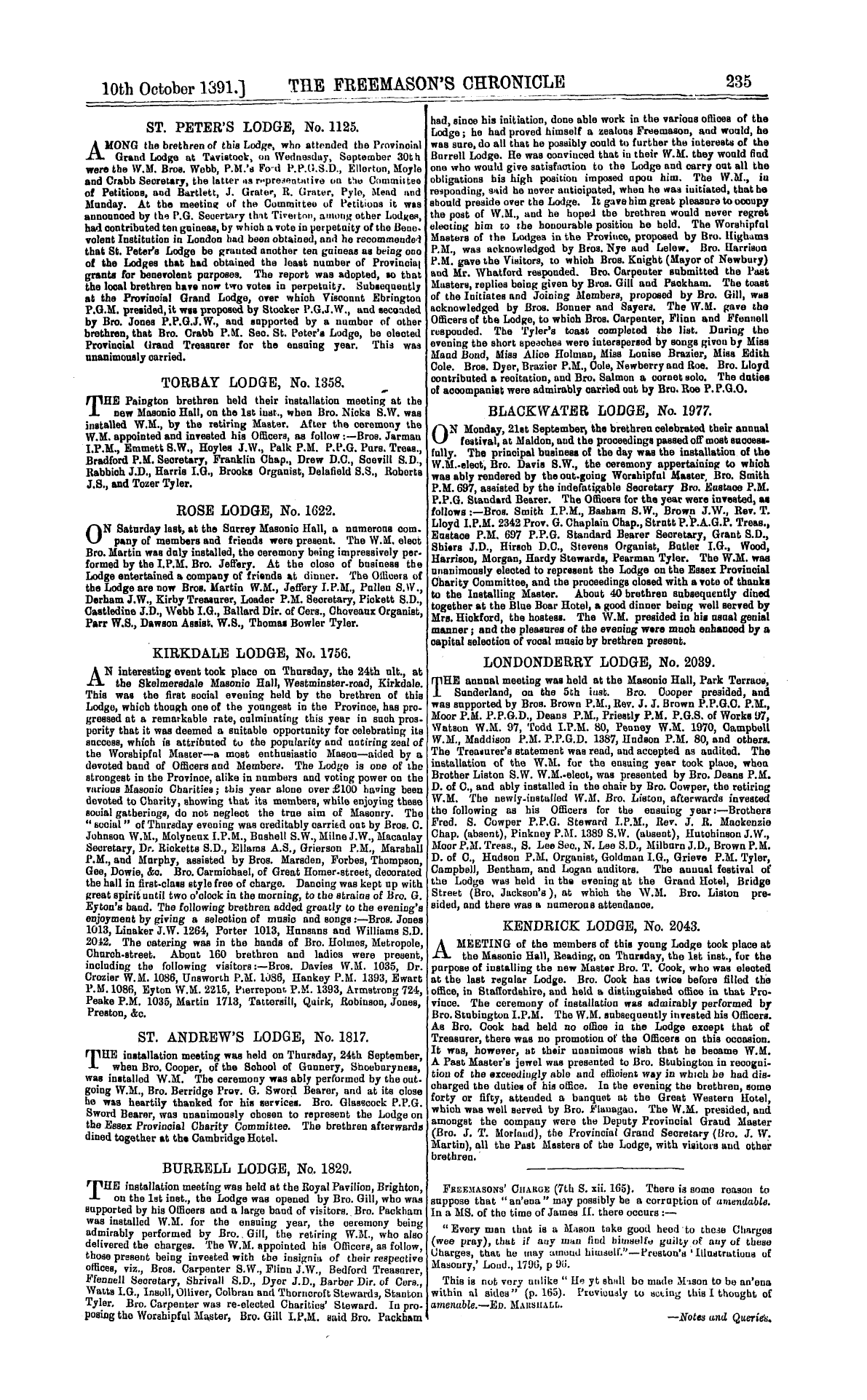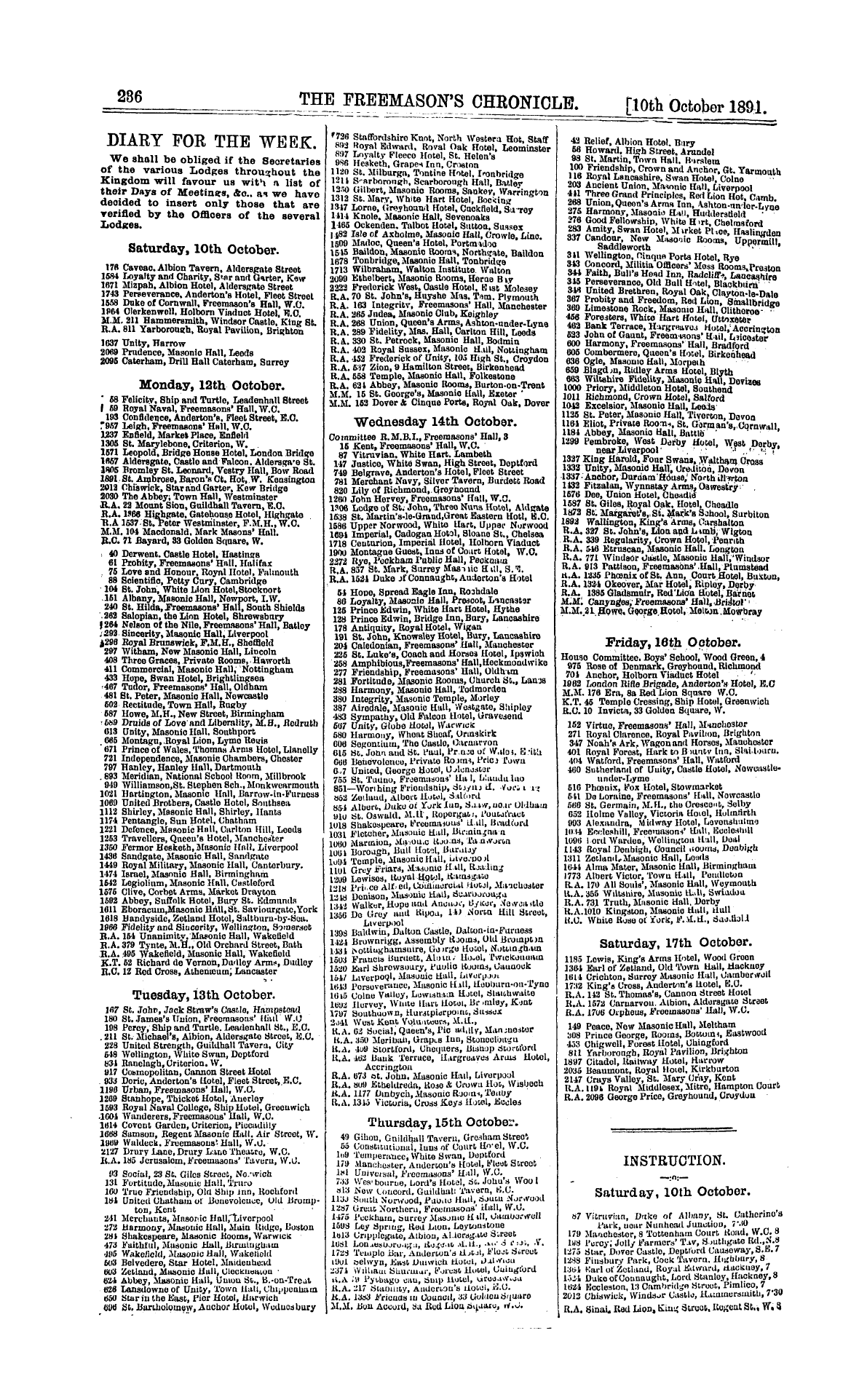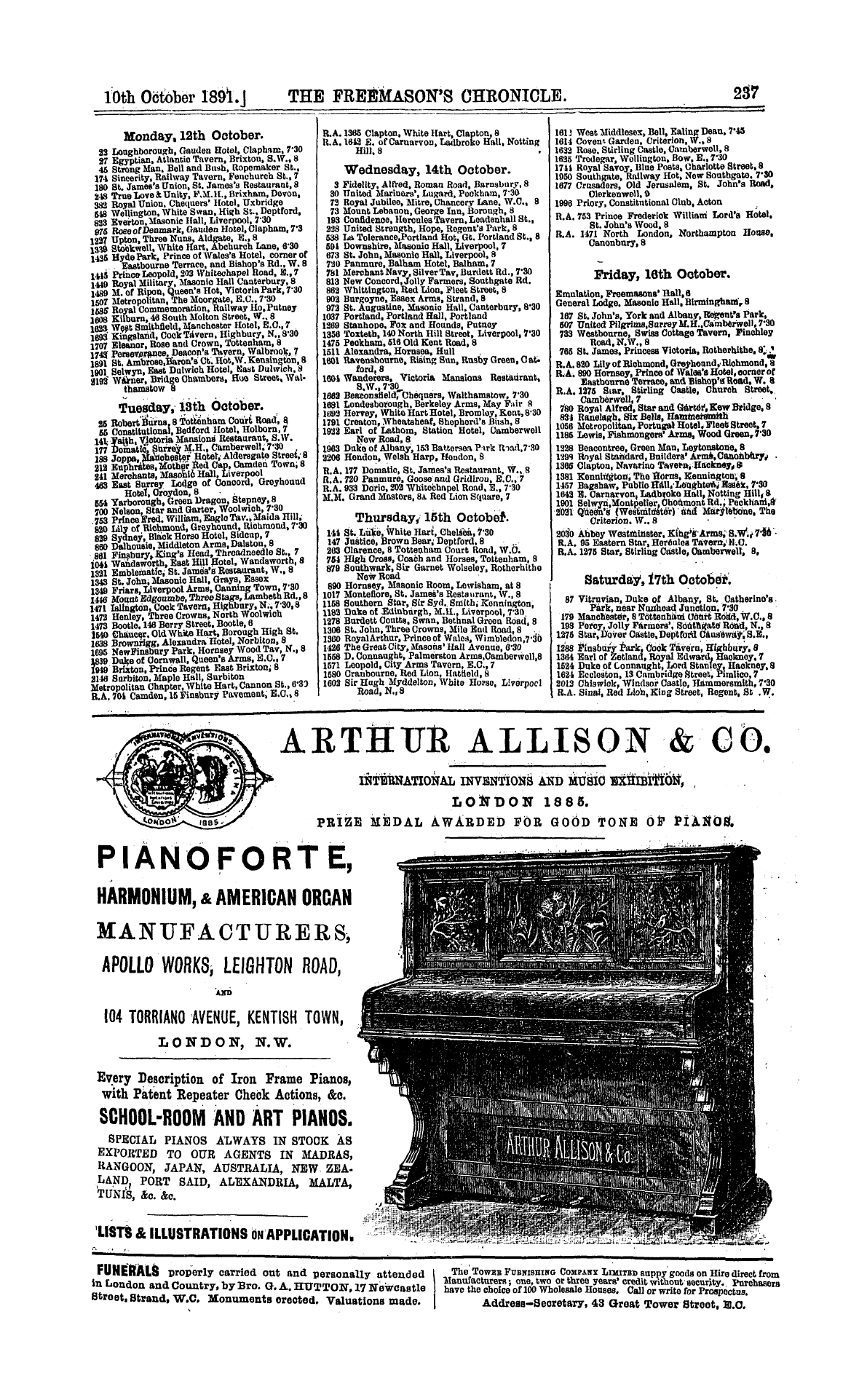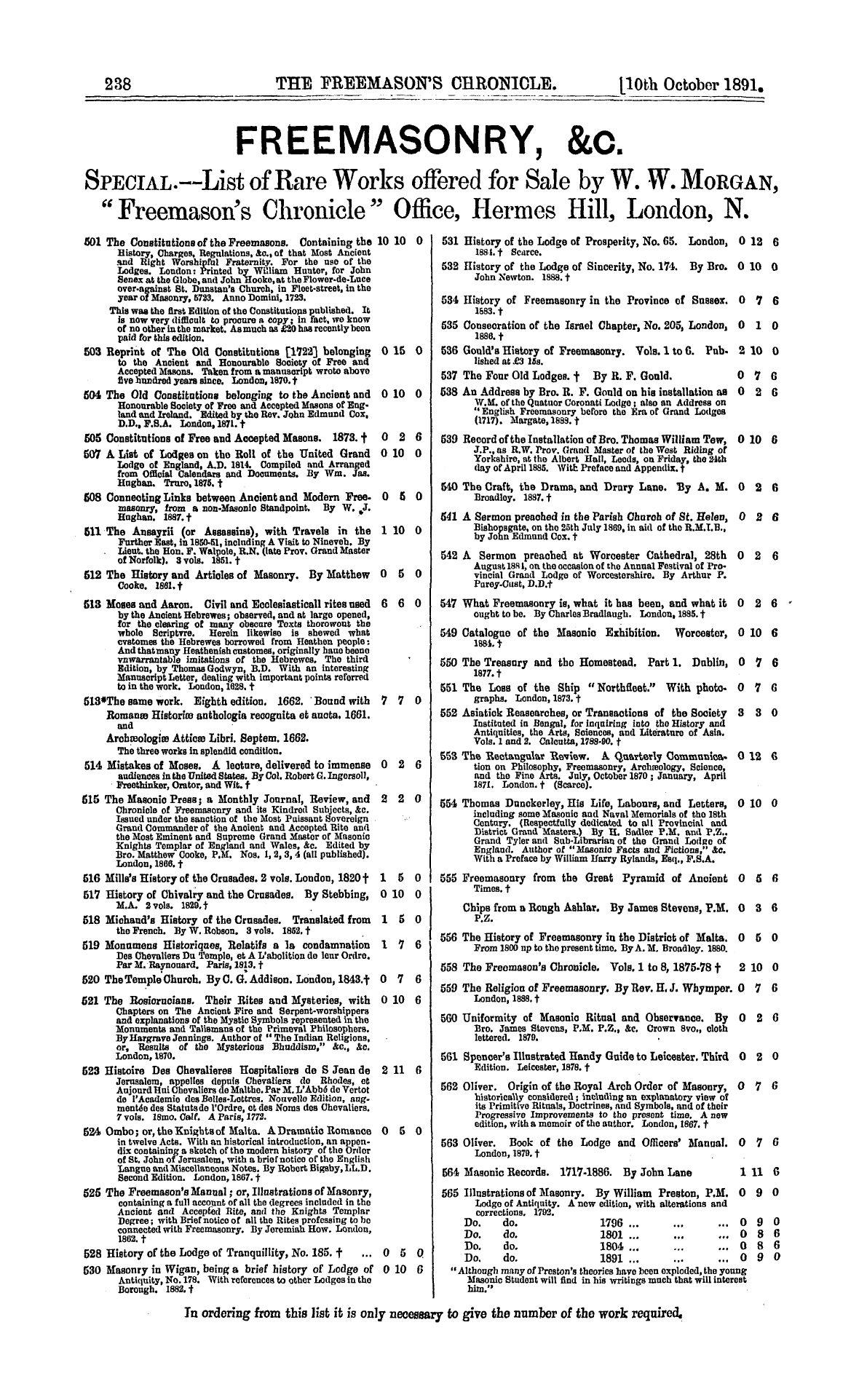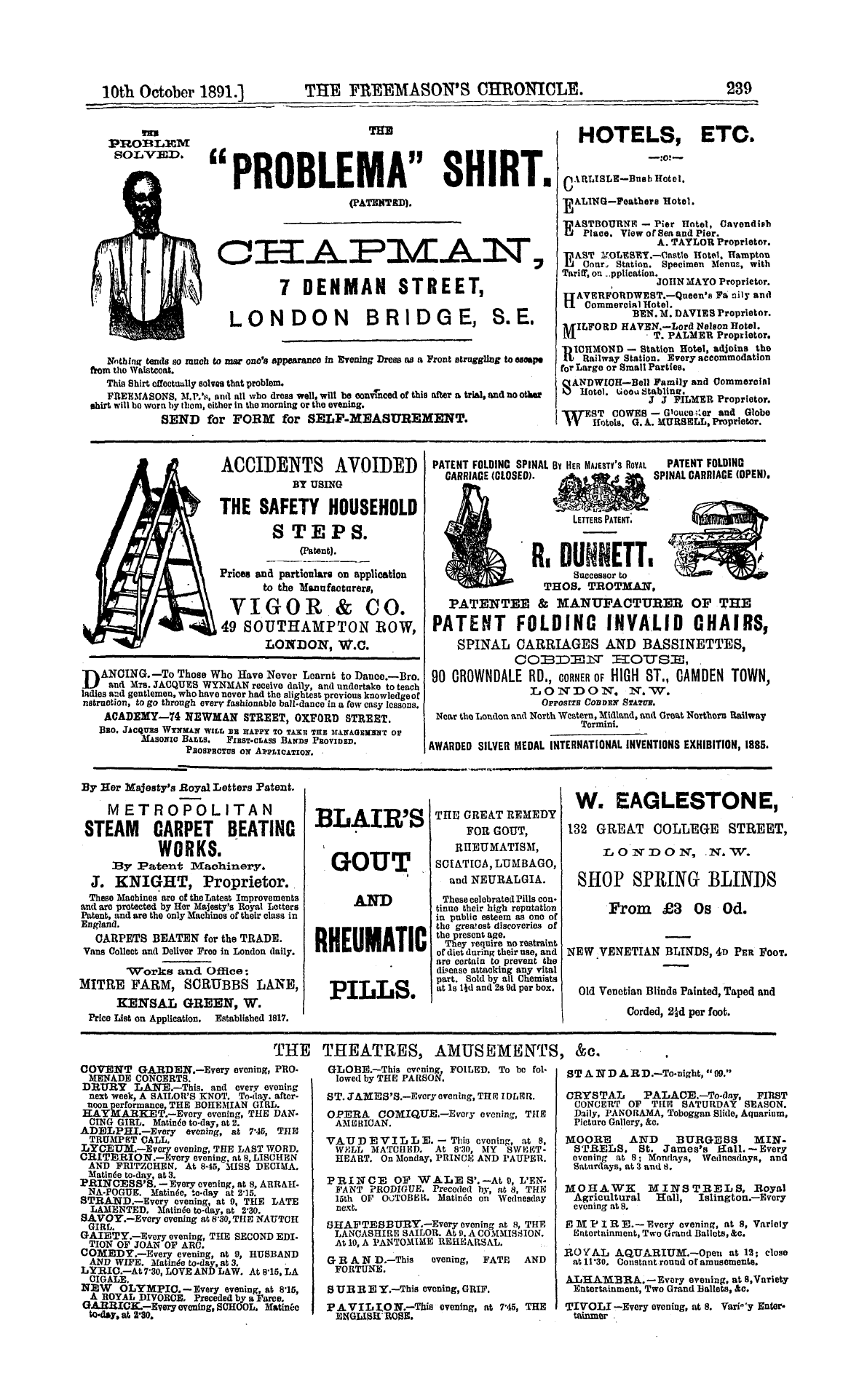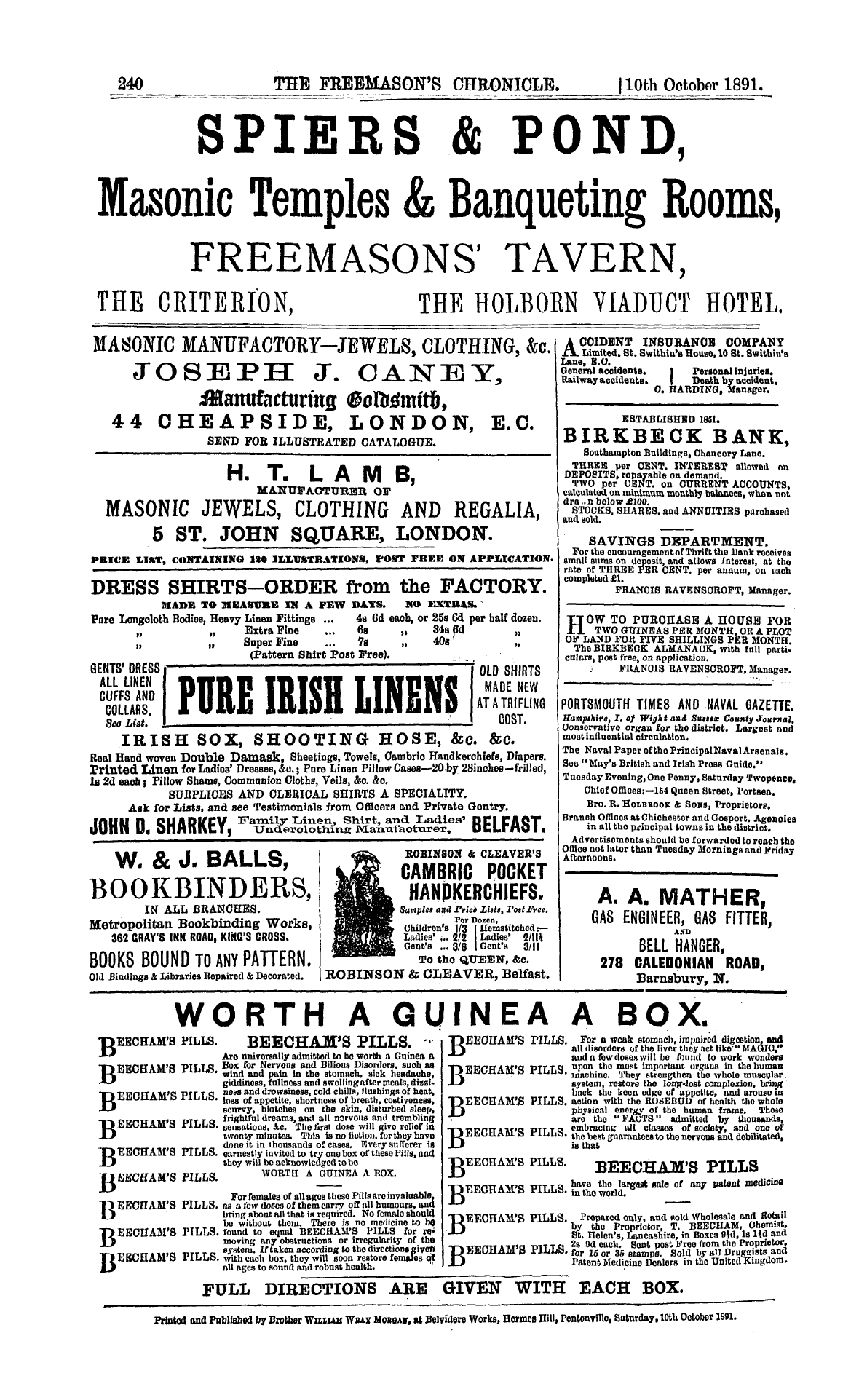-
Articles/Ads
Article A NEW MASONIC HISTORY.* ← Page 2 of 2 Article A NEW MASONIC HISTORY.* Page 2 of 2 Article RELIGIOUS SERVICES IN CANADA. Page 1 of 2 →
Note: This text has been automatically extracted via Optical Character Recognition (OCR) software.
A New Masonic History.*
p laces . Comp . Chapman correctly says , that there is no question as to the importance of tho Holy Royal Arch degree in the Masonic world , nor as to the high placo it holds in perfecting the Craffc degree in England . Its origin cannot be traced to an earlier date than about 1740 , and "it is
clear that the earliest reliable record in English Royal Arch Masonry was brought to the knowledge of the public by Bro . T . B . Whytehead , an eminent Masonic authority in York , in 1879 . " That worthy brofcher had completed a chain of Royal Arch history at York from 7 th February
1762 when a Lodge in " the 4 fch degree of Masonry , commonly called the Most Sublime or Royal Arch , " was opened in a York Lodge afc " Mrs . Chuddock's , at fche Punch Bowl in Stonegate . " It is significant that the words " commonly called " are used in this record ,
showing that the degree was then already known ; but there does not appear to bo evidence obtainable as to when and where ifc had been thitherto practised . Bro . Whytehead remarks also that the first time in which the title " Chapter " waa used instead of " Lodge , " in connection
with this degree was 29 th April 1768 . Another interesting item of information is that the term " Companion " is neither of recent nor of American parentage , bufc had its origin " like much else that is obscure in Freemasonry " at a time when the penman ' s skill and the printer ' s craft
we ' re not trusted with a complete knowledge of the inner Ijjfe of the Ancient Fraternity . The Mark Degree in England , of which it has been said , " there is probably no degree in Freemasonry that can lay claim to greater antiquity thau that of Mark Man , or Mark Mason , and Mark Master Mason , " next receives Brother
Chapman ' s attention . Ifc is not our province here to enter into a lengthy disquisition on the important nature of this essential to the full understanding of Craft Freemasonry , and the connection of the Operative Masonry of antient days therewith . Its symbolical references and teachings
are such as are particularly identified with both Operative and Speculative work , and perfect the entirety of a system which , without it , appears to many as broken and disjointed . In March 1856 tho Grand Lodge of England A . F . and
A . A . Masons , by a small majority , declined to adopt the degree into its system , on the ground thafc ifc " is not positively essential , but a graceful appendage to the degree of a Fellow Craft . " This led to measures which resulted
in the union of all Mark Master Masons tn an organisation which established the now flourishing " Graud Lodge of Mark Master Masons of England and Wales , ancl thc Colonies and Dependencies of tbe British Crown , " as a separate Maaonic body . When narrating events in
connection with the Royal Arch System in Scotland , a few pages further on in this " History , " Bro . Chapman gives some additional interesting particulars in respect of the Mark degree , and illustrates a collection of fac simile Masons' Marks on Cathedrals and other important
buildings from the twelfth century onwards . Vve refer our "Royal Arch" and "Mark" readers to this most useful chapter , wifch full confidence thafc they will find instruction by its perusal . In the second Chapter in this Division , Bro . Chapman opens an inquiry into tho subject of Royal
Arch Masonry iu the United States of America , prefacing his observations by stating thafc the General Grand Chapter R . A . M . in thafc country is the largest organisation of Royal Arch Masons in existence , if nofc numerically tho largest Masonic body iu fcho world , there being " ab the
present writing " one hundred and fifty thousand individual Royal Arch Masons holding membership in tho several Chapters , Grand and Subordinate , owing allegiance to the General Grand Chapter , exclusive of the Grand Chapters of Pennsylvania , Virginia and West Virginia . The interest
in this Chapter is necessarily localised , bufc there is nevertheless much iu relation to the several Grand Chapters mentioned which is worth the general reader ' s attention . Tho Division is , fitly , concluded by a third Chapter on the Order of High Priesthood , an honorary degree , which
includes a system of initiation , and is limited to Royal Arch Masons who have been regularly elected as High Priests to preside over R . A . Chapters . This Chapter ia the contribution of Comp . Edward T . Schultz P . G . O . G ., < fcc , Grand Lodge of Maryland .
Bro . Eugene tirissom , M . D ., LL . D ., & c , P . D . G . M . Grand Lodge of North Carolina , and Bro . W . J . Hughan of England , together contribute thirty pages , in two chapters and au addendum , which form Division XIV ., on the Cryptic Degrees . The several degrees of the Cryptic Rite cannot fail to intensify in fche Uoyal Arch Mason thafc
A New Masonic History.*
great regard which invariably attends his " exaltation " into tbe Supreme Degree . As is pertinently remarked by Bro . Grissom , the mysteries of the seoret vault present to tho true Mason lessons of unexampled forco and beauty . The R . A . legend mav have no historic ? evidence tn support
it ; ifc may be , as some say , " a mythical symbol , and as such we must accept it , bufc we believe that in auy case its lesson is too grand to be rejected as part of the " systmi of Morality" we call Freemasonry . In the words of the Spanish proverb , " Se non e vero , e ben trovafco . " Brother
Grissom's account has chiefly to do with the practice of the Cryptic Rite in connection with American Arch Masonry . In England it is practised under an authority which was tho outcome of a movement originated in 1871 in the Mark Graud Lodge of England , under the first Grand Master ,
the late Rev . Canon Portal , M . A ., and is at present , we believe , the principal rite in what is now known as the Allied Degrees . We commend tbi = i Division of the " History " to the study of Royal Arch and Mark Masons . Division XV ., in two chapters , twenty-four pages , is an
" Euloginm of the Ancient Craffc . " The first Cnapter is contributed by Bro . Chas . T . McClenachan , Historian Grand Lodge State of New York , on the relation of the Symbolic , Capitnlar and Cryptic Degrees to one another , and to Ancient Craft Masonry . This panegyric on the system of
Masonry is naturally of a different character fco those essays which have preceded it . The latter have been essential to a full understanding of the symbolism of our Masonic brotherhood ; the former is a pcoan for the glories and renown of the ancient institution . We should do injustice to this
well-written Chapter by attempting analysis ; ifc should be read in its entirety by the serious and reflective members of our Order . Witb the second Chapter , written by Bro . J . Hamilton Graham , before mentioned , as an Euloginm of
Symbolic Freemasonry , and which is of equal merit with its immediate predecessor , fche Second Part of this valuable "History" terminates . Tho third part , in six divisions , yet awaits onr perusal and notice . ( To be continued . )
Religious Services In Canada.
RELIGIOUS SERVICES IN CANADA .
IN accordance with a recently adopted measure , au order was issued by the Grand Master oi . Freemasond of Canada—Bro . John Ross Robertson—to set abide one d iy in each year for the various Lodges to attend divino
service in a body . The brethren iu Petriha , aiginouted by visiting brethren from JJrigdeu , Oil Spring .-, Oil Cify and Watford , making a total of about 130 , marched in liuel ' iow their Hall to tho Presbyterian Church , where the RJV . A . Beamer delivered an able sermon from the text : —
"On the top of the pillar was lily work , " 1 Kings v . 'i . 22 . We bave in this Chapter a graphic description of that splendid temple built by Solomou . God was tho architect . Tbe pUua aud specifications were given to . Modes on tbe Mouuc , and , first wrought out in the Tabernacle , afterwards enlarged iu iho Temple . Whatever
originates in Heaven—whatever is designed by the Great Architect of the universe—deserves , and demands our attention . Heavenly things are perfect , and earthly things should copy after them . God is nob only au architect , but a practical builder . lie is also a master iu art decorations . It is a significant fact that the Sou of God was u
carpenter , and the idea cf building and decorating runs through nearly all creature life . Man himself is a builder . He builds fortune * houses , cities , empires , but greater than all , he is the builder of hid own lite , and if there be any defect in this wonderful Temple called life , the fault is ia the builder , not in the architect , nor ia the plans ,
nor in material , tor God is the architect and he furnishes the material . He has not only given u * the volume of the Sacred Law as a text book on life building , but he has given the idea tangible existence iu the perfect life of His tion . 1 . —Solomon's Temple was built by foreign skill . The old Hebrews
were not artists , aud Hiram , King of Tyre , sent Solomou the necessary assistance . Hiram Abif , who superintended tho work , is said to have been inspired as a cunning workman . 2 . —At the entrance of the Temple was a porch supported by two brazen pillars . The one on the right was named Jachin , the one ou
the left Boaz . Jachin literally means " He that strenthens , " or "Will establish ; " Boaz means "In strength . " The two words together signify " In strength shall this my house be established . " "Symbolizing the eternally continuing fixad relation in which Jehovah stood to hia peoplo whom he had redeemed , and amooj' wtioui
lie condescended to dwell . " Following the pillars up to ihe top wo discover lily work wbich adoru the massive columns with exquisite beauty . Altogether we have in these pillars the divine idea of it
perfect figure—gracefulness , embodied in strength , stability and beauty . These words describe all the works of God . The motion of the universe represents strength , its continuity represents stability , its variety of feature and adornment , beauty . Tranter this thought
Note: This text has been automatically extracted via Optical Character Recognition (OCR) software.
A New Masonic History.*
p laces . Comp . Chapman correctly says , that there is no question as to the importance of tho Holy Royal Arch degree in the Masonic world , nor as to the high placo it holds in perfecting the Craffc degree in England . Its origin cannot be traced to an earlier date than about 1740 , and "it is
clear that the earliest reliable record in English Royal Arch Masonry was brought to the knowledge of the public by Bro . T . B . Whytehead , an eminent Masonic authority in York , in 1879 . " That worthy brofcher had completed a chain of Royal Arch history at York from 7 th February
1762 when a Lodge in " the 4 fch degree of Masonry , commonly called the Most Sublime or Royal Arch , " was opened in a York Lodge afc " Mrs . Chuddock's , at fche Punch Bowl in Stonegate . " It is significant that the words " commonly called " are used in this record ,
showing that the degree was then already known ; but there does not appear to bo evidence obtainable as to when and where ifc had been thitherto practised . Bro . Whytehead remarks also that the first time in which the title " Chapter " waa used instead of " Lodge , " in connection
with this degree was 29 th April 1768 . Another interesting item of information is that the term " Companion " is neither of recent nor of American parentage , bufc had its origin " like much else that is obscure in Freemasonry " at a time when the penman ' s skill and the printer ' s craft
we ' re not trusted with a complete knowledge of the inner Ijjfe of the Ancient Fraternity . The Mark Degree in England , of which it has been said , " there is probably no degree in Freemasonry that can lay claim to greater antiquity thau that of Mark Man , or Mark Mason , and Mark Master Mason , " next receives Brother
Chapman ' s attention . Ifc is not our province here to enter into a lengthy disquisition on the important nature of this essential to the full understanding of Craft Freemasonry , and the connection of the Operative Masonry of antient days therewith . Its symbolical references and teachings
are such as are particularly identified with both Operative and Speculative work , and perfect the entirety of a system which , without it , appears to many as broken and disjointed . In March 1856 tho Grand Lodge of England A . F . and
A . A . Masons , by a small majority , declined to adopt the degree into its system , on the ground thafc ifc " is not positively essential , but a graceful appendage to the degree of a Fellow Craft . " This led to measures which resulted
in the union of all Mark Master Masons tn an organisation which established the now flourishing " Graud Lodge of Mark Master Masons of England and Wales , ancl thc Colonies and Dependencies of tbe British Crown , " as a separate Maaonic body . When narrating events in
connection with the Royal Arch System in Scotland , a few pages further on in this " History , " Bro . Chapman gives some additional interesting particulars in respect of the Mark degree , and illustrates a collection of fac simile Masons' Marks on Cathedrals and other important
buildings from the twelfth century onwards . Vve refer our "Royal Arch" and "Mark" readers to this most useful chapter , wifch full confidence thafc they will find instruction by its perusal . In the second Chapter in this Division , Bro . Chapman opens an inquiry into tho subject of Royal
Arch Masonry iu the United States of America , prefacing his observations by stating thafc the General Grand Chapter R . A . M . in thafc country is the largest organisation of Royal Arch Masons in existence , if nofc numerically tho largest Masonic body iu fcho world , there being " ab the
present writing " one hundred and fifty thousand individual Royal Arch Masons holding membership in tho several Chapters , Grand and Subordinate , owing allegiance to the General Grand Chapter , exclusive of the Grand Chapters of Pennsylvania , Virginia and West Virginia . The interest
in this Chapter is necessarily localised , bufc there is nevertheless much iu relation to the several Grand Chapters mentioned which is worth the general reader ' s attention . Tho Division is , fitly , concluded by a third Chapter on the Order of High Priesthood , an honorary degree , which
includes a system of initiation , and is limited to Royal Arch Masons who have been regularly elected as High Priests to preside over R . A . Chapters . This Chapter ia the contribution of Comp . Edward T . Schultz P . G . O . G ., < fcc , Grand Lodge of Maryland .
Bro . Eugene tirissom , M . D ., LL . D ., & c , P . D . G . M . Grand Lodge of North Carolina , and Bro . W . J . Hughan of England , together contribute thirty pages , in two chapters and au addendum , which form Division XIV ., on the Cryptic Degrees . The several degrees of the Cryptic Rite cannot fail to intensify in fche Uoyal Arch Mason thafc
A New Masonic History.*
great regard which invariably attends his " exaltation " into tbe Supreme Degree . As is pertinently remarked by Bro . Grissom , the mysteries of the seoret vault present to tho true Mason lessons of unexampled forco and beauty . The R . A . legend mav have no historic ? evidence tn support
it ; ifc may be , as some say , " a mythical symbol , and as such we must accept it , bufc we believe that in auy case its lesson is too grand to be rejected as part of the " systmi of Morality" we call Freemasonry . In the words of the Spanish proverb , " Se non e vero , e ben trovafco . " Brother
Grissom's account has chiefly to do with the practice of the Cryptic Rite in connection with American Arch Masonry . In England it is practised under an authority which was tho outcome of a movement originated in 1871 in the Mark Graud Lodge of England , under the first Grand Master ,
the late Rev . Canon Portal , M . A ., and is at present , we believe , the principal rite in what is now known as the Allied Degrees . We commend tbi = i Division of the " History " to the study of Royal Arch and Mark Masons . Division XV ., in two chapters , twenty-four pages , is an
" Euloginm of the Ancient Craffc . " The first Cnapter is contributed by Bro . Chas . T . McClenachan , Historian Grand Lodge State of New York , on the relation of the Symbolic , Capitnlar and Cryptic Degrees to one another , and to Ancient Craft Masonry . This panegyric on the system of
Masonry is naturally of a different character fco those essays which have preceded it . The latter have been essential to a full understanding of the symbolism of our Masonic brotherhood ; the former is a pcoan for the glories and renown of the ancient institution . We should do injustice to this
well-written Chapter by attempting analysis ; ifc should be read in its entirety by the serious and reflective members of our Order . Witb the second Chapter , written by Bro . J . Hamilton Graham , before mentioned , as an Euloginm of
Symbolic Freemasonry , and which is of equal merit with its immediate predecessor , fche Second Part of this valuable "History" terminates . Tho third part , in six divisions , yet awaits onr perusal and notice . ( To be continued . )
Religious Services In Canada.
RELIGIOUS SERVICES IN CANADA .
IN accordance with a recently adopted measure , au order was issued by the Grand Master oi . Freemasond of Canada—Bro . John Ross Robertson—to set abide one d iy in each year for the various Lodges to attend divino
service in a body . The brethren iu Petriha , aiginouted by visiting brethren from JJrigdeu , Oil Spring .-, Oil Cify and Watford , making a total of about 130 , marched in liuel ' iow their Hall to tho Presbyterian Church , where the RJV . A . Beamer delivered an able sermon from the text : —
"On the top of the pillar was lily work , " 1 Kings v . 'i . 22 . We bave in this Chapter a graphic description of that splendid temple built by Solomou . God was tho architect . Tbe pUua aud specifications were given to . Modes on tbe Mouuc , and , first wrought out in the Tabernacle , afterwards enlarged iu iho Temple . Whatever
originates in Heaven—whatever is designed by the Great Architect of the universe—deserves , and demands our attention . Heavenly things are perfect , and earthly things should copy after them . God is nob only au architect , but a practical builder . lie is also a master iu art decorations . It is a significant fact that the Sou of God was u
carpenter , and the idea cf building and decorating runs through nearly all creature life . Man himself is a builder . He builds fortune * houses , cities , empires , but greater than all , he is the builder of hid own lite , and if there be any defect in this wonderful Temple called life , the fault is ia the builder , not in the architect , nor ia the plans ,
nor in material , tor God is the architect and he furnishes the material . He has not only given u * the volume of the Sacred Law as a text book on life building , but he has given the idea tangible existence iu the perfect life of His tion . 1 . —Solomon's Temple was built by foreign skill . The old Hebrews
were not artists , aud Hiram , King of Tyre , sent Solomou the necessary assistance . Hiram Abif , who superintended tho work , is said to have been inspired as a cunning workman . 2 . —At the entrance of the Temple was a porch supported by two brazen pillars . The one on the right was named Jachin , the one ou
the left Boaz . Jachin literally means " He that strenthens , " or "Will establish ; " Boaz means "In strength . " The two words together signify " In strength shall this my house be established . " "Symbolizing the eternally continuing fixad relation in which Jehovah stood to hia peoplo whom he had redeemed , and amooj' wtioui
lie condescended to dwell . " Following the pillars up to ihe top wo discover lily work wbich adoru the massive columns with exquisite beauty . Altogether we have in these pillars the divine idea of it
perfect figure—gracefulness , embodied in strength , stability and beauty . These words describe all the works of God . The motion of the universe represents strength , its continuity represents stability , its variety of feature and adornment , beauty . Tranter this thought










